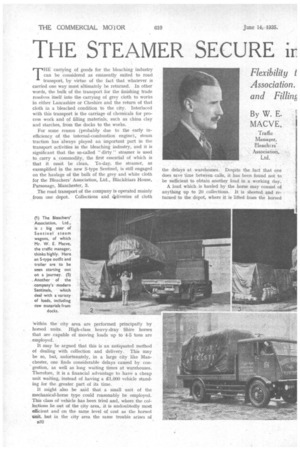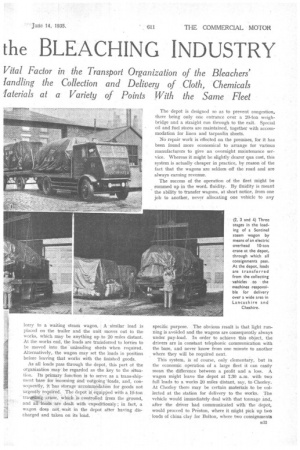THE STEAMER SECURE ir the BLEACHING INDUSTRY
Page 42

Page 43

Page 44

If you've noticed an error in this article please click here to report it so we can fix it.
Flexibility Association. and Fillitq Vital Factor in the Transport Organization of the Bleachers' fondling the Collection and Delivery of Cloth, Chemicals laterials at a Variety of Points With the Same Fleet
THE carrying of goods for the bleaching industry can be considered as eminently suited to road transport, by virtue of the fact that whatever is carried one way must ultimately be returned. In other words, the bulk of the transport for the finishing trade resolves itself into the carrying of grey cloth to works in either Lancashire or Cheshire and the return of that cloth in a bleached condition to the city. Interlaced with this transport is the carriage of chemicals for process work and of filling materials, such as china clay and starches, from the docks to the works.
For some reason (probably due to the early inefficiency of the internal-combustion engine), steam traction has always played an important part in the transport activities in the bleaching industry, and it is significant that the so-called " dirty " steamer is used to carry a commodity, the first essential of which is that it must be clean. To-day, the steamer, as exemplified in the new S-type Sentinel, is still engaged on the haulage of the bulk of the grey and white cloth for the Bleachers' Association, Ltd., Blackfriars House, Parsonage, Manchester, 3.
The road transport of the company is operated mainly from one depot. Collections and dAiveries of cloth
Within the city area are performed principally by horsed units. High-class heavy-dray Shire horses that are capable of moving loads up to 4-5 tons are .employed.
It may be argued that this is an antiquated method of dealing with collection and delivery. This may be so, but, unfortunately, in a large city like Manchester, one finds considerable delays caused by congestion, as well as long waiting times at warehouses. Therefore, it is a financial advantage to have a cheap unit waiting, instead of having a £1,IXIO vehicle standing for the greater part of its time.
It might also be said that a small unit of the rneclaanical-horse type could reasonably be employed. This class of vehicle has been tried and, where the collections lie out of the city area, it is undoubtedly most efficient and on the same level of cost as the horsed unit, but in the city area the same trouble arises of
the delays at warehouses. Despite the fact that one does save time between calls, it has been found not to be sufficient to obtain another load in a working day.
A load which, is hauled by the horse may consist of anything up to 20 collections. It is sheeted and returned to the depot, where it is lifted from the horsed lorry to a waiting steam wagon. A similar load is placed on the trailer and the unit moves out to the works, which may be anything up to 20 miles distant. At the works end, the loads are transferred to lorries to be moved into the unloading sheds when required. Alternatively, the wagon may set the loads in position before leaving that works with the finished goods.
As all loads pass through the depot, this part of the organization may be regarde,d as the key to the situation. Its primary function is to serve as a trans-shipment base for incoming and outgoing loads, and, consequently, it has Storage accommoclatiOn for goods not urgently required. The depot is equipped with a 10-ton traviling cran .which is controlled from the ground, and all 'loads are dealt with expeditiously ; in fact, a wagon does not wait in the depot after having discharged and taken on its load. The depot is designed so as to prevent congestion; there being only one entrance over a 20-ton weighbridge and a straight run through to the exit. Special oil and fuel stores are maintained, together with accommodation for linen and tarpaulin sheets.
No repair work is 'effected on the premises, for it has been found more economical to arrange for various manufacturers to give an overnight maintenance service. Whereas it might be slightly dearer qua cost, this system is actually cheaper in practice, by reason of the fact that the wagons are seldom off the road and are always earning revenue.
The success of the operation of the fleet might be summed up in the word, fluidity_ By fluidity is meant the ability to transfer wagons, at short notice, from one job to another, never allocating one vehicle to any
specific purpose. The obvious result is that light running is avoided and the wagons are consequently always under pay-load. In order to achieve this object, the drivers are in constant telephonic communication with the base, and never know from one minute to another where they will be required next.
This system, is of course, only elementary, but in the economic operation of a large fleet it can easily mean the difference between a profit and a loss. A wagon might leave the depot at 7.30 a.m. with two full loads to a works 20 miles 'distant, say, to Charley. At Chorley there may be certain materials to be collected at the station for delivery to the works. The vehicle would immediately deal with that tonnage and, after the driver had communicated with the depot, would proceed to Preston, where it Might pick up two loads of china clay for Bolton, where two consignments
of white cloth might be obtained from one of the works in the locality.
The vehicle would then return to Manchester, and would probably have run a maximum of 70 miles, carrying, perhaps, 30-40 tons. The whole essence of this quick movement is that everything is loaded upon trays and terminal delays are eliminated.
It has already been pointed out that apart from the cloth, chemicals are collected from various manufacturers and delivered to the works. This haulage is interlaced with the cloth traffic and a wagon will not proceed with only half a load, The question of operating costs and statistics apertaining to the running of the fleet are matters which are of the utmost importance, and a brief discussion of the systems used will be of interest. Due to the partictilar type of work, coupled with the short mileages run and the need for fluidity, an involved method is adopted which might, to some people, be considered unwieldy and more complicated than necessary.
The System Behind the Fleet.
The system is based on three factors—revenue, operating cost, arid efficiency of employment. The first two, of course, need no explanation. The third factor is undoubtedly the most important in determining whether the business is carried on at a profit or a loss, and by efficiency of employment is meant the ratio between the time worked and the working time.
Thus, the number of days for which a given vehicle actually works is related to the number of possible working days, and the closer these two figures the higher the efficiency in the working of the fleet. It is easy to estimate revenue and operating cost with reasonable accuracy in respect of actual working days, but lost time plays such an important part in either reducing one or increasing the other, that the importance of such a record can hardly be overstated.
The efficiency of employment is obviously considered in conjunction with other factors, such as tonnage and mileage per vehicle-day, so that apart from . the figures of actual cost and revenue, such data as tonnage and mileage per day worked, cost and revenue per day worked, and fuel and oil efficiency of each wagon are produced.
At the end of each month, these figures are related to the actual jobs, and information is produced showing whether or not any given operation has been profitable. Monthly fleet averages are also calculated, which are, in turn, collated into six-monthly statements and ultimately compared, agreed and adjusted with, the trading account for that period.
Unfortunately, space will not permit of a lengthy discussion of this interesting subject of operating costs. The situation might be summed up by saying that, if the majority of operators did adopt some comprehensive method of ascertaining precise costs, it would, to a large number, probably mean the difference between a loss and a profit.
The writer. has often heard the remark that most ancillary fleets are merely show undertakings, but it should be stated that, so far as the Bleachers' Association's fleet is concerned, it has to bear its quota of standing charges and show a trading account at the end of each financial period, which must inevitably yield' a profit. In other words, the traffic undertaking of the company competes with all other forms of transport on a fair basis.
A Creditable Achievement.
There is one other aspect which might be introduced and that is the question of road accidents, coupled with insurance. For many years the Association's fleet has been quoted on the insurance market as being one of the finest motor risks in the country. Claims are few and this fact is undoubtedly due to the close supervision of all men, a detailed scrutiny of all accident reports which are made, and the earnest desire on the part of the men to conduct themselves in a proper manner, having regard to the law and other road users.




















































































